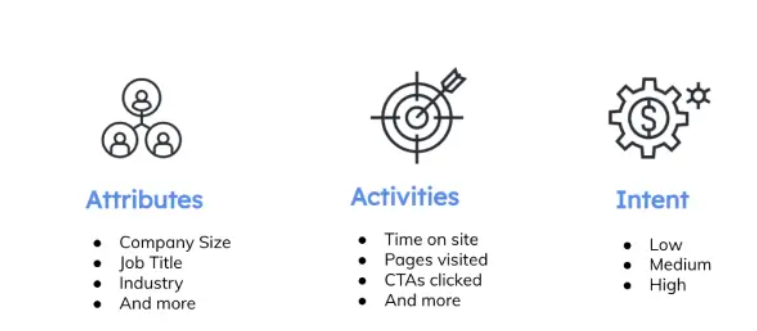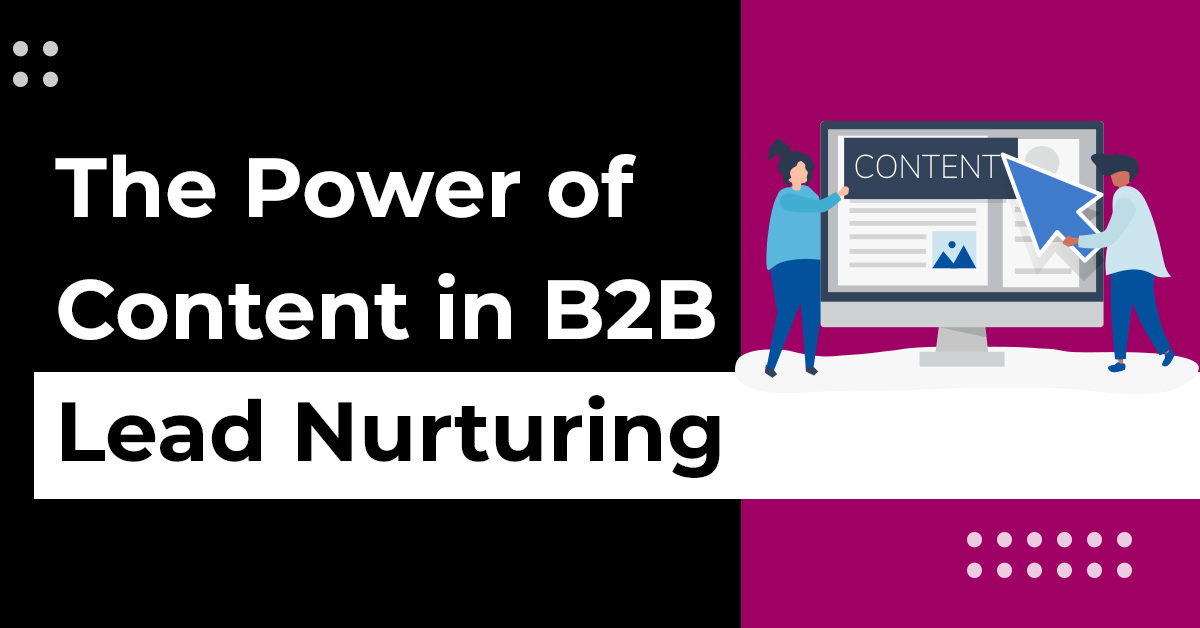A marketer’s job is to generate leads for the company’s top of the sales funnel.
But do you really believe that those leads will actively move themselves through the whole sales process or funnel? That’d be really unusual!
According to a survey, just 27% of leads are truly ready to buy at the time they are created. This means that over two-thirds of your prospects require more follow-up before they are ready to make a purchase.
If you want to generate revenue from qualified leads, your company needs a lead nurturing program that incorporates effective marketing website design.
For that purpose, we have compiled a full B2B funnel guide. Starting at the top of the funnel (TOFU) and ending at the bottom of the funnel (BOFU), you will learn how to construct and improve content B2B lead-generating funnels.
So, let’s get started.
What is lead nurturing?

(Sample lead nurturing strategy blueprint)
To create and maintain a rapport with current, prospective, and former clients is the essence of lead nurturing. As a result of a lead’s positive experience with the brand’s helpful resources, they are more likely to become a customer.
Email, digital marketing, and advertisements are just a few methods that may be used for this purpose. Lead nurturing relies heavily on content, which must be tailored to certain buyer profiles and addressees’ pain points.
Now, if you pardon us, we’d like to use an analogy to explain ourselves. Please bear with us.
Content marketing is like a first date
Let’s assume you go on a date with someone you’re incredibly drawn to. Perhaps you two eat pasta and meatballs while serenading each other in an alley. In your gut, butterflies are hatching from the caterpillars you ate for breakfast. You two went for a pleasant stroll at the night’s end. So far, so good.
Now, the next day, you want to plan a second date. What would you do?
A. Keep your eyes glued to your phone, hoping they’ll contact you.
B. Share a nice selfie on Instagram and hope they’ll like it.
C. Send a friendly text to initiate a conversation.
If you selected C, you have a good grasp of how to cultivate a potential prospect’s interest. Just like in content marketing, where initiating a meaningful conversation and building a genuine connection is vital in nurturing lasting relationships with your audience.
All right, we’ve had our fun. Enough of the analogies.
Why is lead nurturing important for the B2B business model?
There’s no denying that increasing your sales chances is excellent for the company, but how efficient is it, and why should you use it yourself?
To begin, around 96% of visitors to your website are not prepared to buy. At first sight, this may seem like a discouraging number, but it actually conceals a wealth of opportunity for the astute.
About 96 out of 100 initial interactions of visitors to your site are not prepared to make a purchase at this time. Yet they nevertheless visited by clicking on a link. It indicates (assuming the traffic source is legit) that they are at least mildly interested in what you offer.

Image Source: Exploding Topics
It’s not about making a quick buck when developing leads. The goal is to maintain favorable consumer associations with your brand by meeting the expectations of your target audience.
You can make your entire customer acquisition approach more responsive with some clever lead nurturing.
The building blocks of a successful B2B lead nurturing campaign
While considering your B2B lead nurturing strategy, keep these key points in mind.
1. Understand buyer personas

Image Source: Kalungi
If you don’t have a clear picture of your ideal client, also known as your buyer personas, your marketing efforts will be fruitless.
So, putting yourself in your target market’s shoes is important. Get to know their wants, problems, and goals thoroughly. For instance, creating a customer database could provide valuable insights into your potential customers’ specific job roles and responsibilities. This data will ultimately help map your outreach strategy, by showing how you can address pain points.
Conduct surveys and conversations with B2B customers, or examine their support tickets.

Image Source: Xtensio
2. Personalization
A lead nurturing approach that doesn’t include personalization is doomed to fail. Prospects will feel more comfortable doing business with you if you write them casual emails, use their name, and speak to them in a conversational tone.
3. Educate your prospects
Educating prospects according to where they are in the buyer journey is crucial in closing the sales cycle. The customer journey can be broken down into 3 primary stages:

Image Source: Drewl
- Awareness phase: Here, you want to raise the profile and attract the interest of prospective customers. You want to increase both free and paid site visitors and spread the word about your company.
- Consideration phase: At this point, potential customers are forming an opinion of your business based on factors, including whether or not you can meet their demands. In a nutshell, it’s the phase where your services are investigated more compared to those of competitors.
- Decision phase: The goal of the last stage of the lead generation process is to increase conversions by persuading consumers to perform the required action. How? Through collaboration between the departments and the use of sales enablement content. To streamline this process further, it’s crucial to generate SOPs that guide these inter-departmental collaborations and negotiations. The latter helps allay the fears of buyers during negotiations.

Content creation best practices for a B2B lead nurturing funnel

Image Source: Waseembashir
Stage 1: TOFU (top of the funnel): Awareness
At this point, your content’s primary goals are to bring in new readers and spread the word about your business.
Rather than being promotional, this type of material will educate and inform your target audience about your topic. The objective of providing material is to increase exposure to and recognition of your brand, including social media benchmarks.
A fantastic customer experience is crucial for potential consumers to establish a “warm-up” towards your business and services.
Here are a few suitable content assets for this step of the inside sales process:
- A collection of “how-to” articles
- Data-driven industry insight pieces
- Thought leadership articles
- Infographics
- Ebooks/whitepapers
- Lists
- Resources/templates
A B2B buyer’s journey through the marketing funnel is greatly aided by establishing credibility as they progress. The content you create and distribute can help you become recognized as an industry leader.
In this way, you’re giving them something of value at no cost to yourself. However, by doing so, you are sowing the seeds of trust.
You see, the trustworthiness of a business is far more important to B2B customers. Rather than making one-time purchases, they choose to get into long-term relationships and make substantial expenditures.
KPIs to keep an eye on:
Find indicators of common problems. In order to improve your TOFU results, you need to first identify the obstacles or metrics that could be holding you back. Some examples of this are:
- Low website/page traffic
- Irrelevant traffic
- High bounce rates
- Conversion rate from landing and blog pages
Stage 2: MOFU (middle of the funnel): Consideration
Now, site visitors have transformed into potential customers.
At this point in the sales process, the emphasis of your material should shift to your offerings. You want to do two things here:
- Make them more knowledgeable about your products
- Convince them that you offer great value
A well-honed MOFU engagement and lead-management approach generates four to ten times more responses than bulk email blasts and cold calling.
Your lead has recognized and taken action on their problem or objective. They’re eager to examine solutions, and you can support them with quality educational assets:
- Email newsletters
- Case studies
- Research
- Event promotion through inbound marketing
- Customer success stories
- Product demo videos
- Webinars
- Retargeting and remarketing
Naturally, funnel phases overlap. You may still generate instructive stuff like studies, but the focus is now on your product/business offerings. Calls to action on your services pages, email signup forms, and contact pages will have a stronger correlation with content marketing at this funnel level.
However, you must balance brand promotion with audience education.
Storytelling and the marketing funnel go hand in hand, especially when discussing content marketing.
The “Awareness” phase is often referred to as the “scene-setting” phase. Here, you’re giving an overview of your field and its problems. The “Consideration” stage is where the protagonist (you) is first introduced. Based on the character’s actions and words, the audience will make a decision whether or not they like them.
KPIs to keep an eye on:
- Views, clicks, and downloads of sent emails; these evaluate how interested leads are in your website and lead nurturing efforts.
- Blog efficacy metrics such as dwell time, engagement, average reading time, social share, and scroll depth; assess the impact of mid-funnel initiatives on bringing leads closer to conversion.
Stage 3: BOFU (bottom of the funnel): Conversion
You’ve finally reached the big show! Now is the time to strike.
The decision stage content is the clapping spectator at the end of the buyer’s journey and the sales process. In other words, it’s the final boost of confidence.
- The client is already familiar with your company and its offerings.
- But why should they use your service instead of another one? In what ways will they benefit from working with you?
- How do you set yourself apart from your rivals?
Some appropriate content pipeline at this point includes:
- Product comparisons
- Case studies
- Customer testimonials
Product reviews - Product demos
- Sales or service page content
Always keep your target audience in mind while developing and promoting content for the decision stage. Your writing here will center on the goods and services you offer, explaining them in depth and answering any questions readers may have.
If you fall into the trap of only highlighting the features, you risk losing their attention.
KPIs to keep an eye on
Finally, these are some of the most important indicators to track during BOFU:
- Conversion rate
- Cost to acquire a new customer (CAC)
- Calculating the ROI (return on investment)
Bonus Tip: Always remember the golden rule – “What’s in it for me?”
Put yourself in your consumers’ position and ask yourself, “What’s in it for me?” Constantly thinking about the customer’s position in the buying cycle can help you produce content that resonates with them.
You may provide value by addressing a frequently asked question or by providing a return on investment (ROI) calculator demonstrating your product’s financial benefits.
As vital as it is to emphasise the benefits your solution promises, it is just as crucial to emphasise the problems your customers will solve and the improvements they will experience.
Conclusion
Lead nurturing is not something that can be set up once and forgotten. Instead, you need to do some trial and error to figure out how to best grab leads and nurture them. Metrics and A/B testing should be continuously analysed for the best results. If managing lead nurturing seems overwhelming and time-consuming, consider reaching out to a marketing consultant.
We want to emphasise that none of these suggestions is meant to be taken as gospel. Even if we classify blogs as “top of the funnel” material, it doesn’t mean they can’t be used to promote “bottom of the funnel” deals. All of the content types discussed here can be utilised interchangeably across the various funnel phases.
The most effective course of action you could take is to accept and implement a methodical strategy. Don’t hesitate to start conversations and tailor your approach to individual customers.
Don’t worry about anything other than giving your readers the best information possible. It’s a certain method for establishing long-lasting bonds of trust and devotion.










